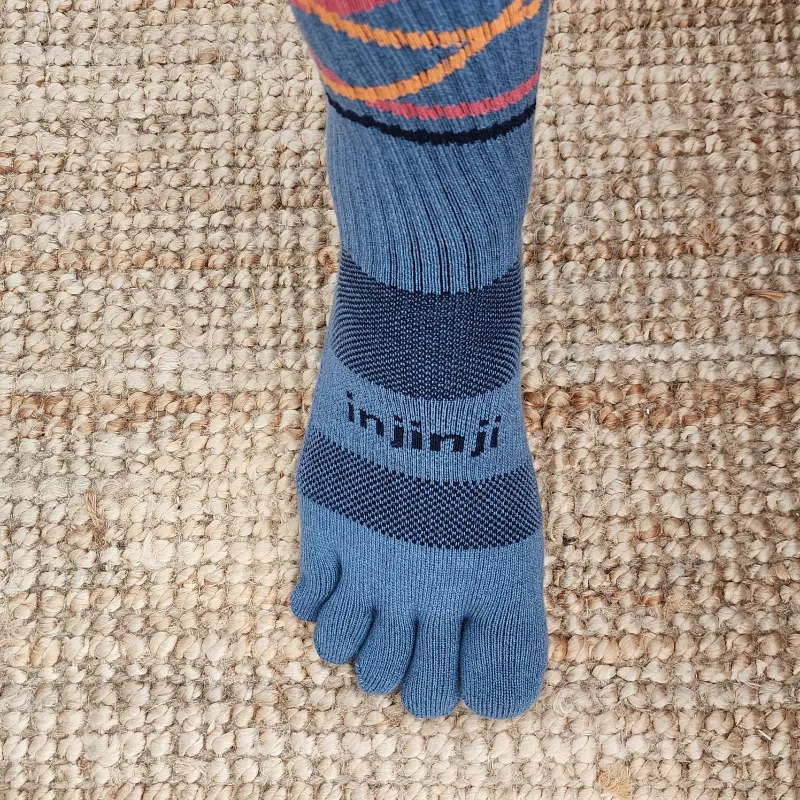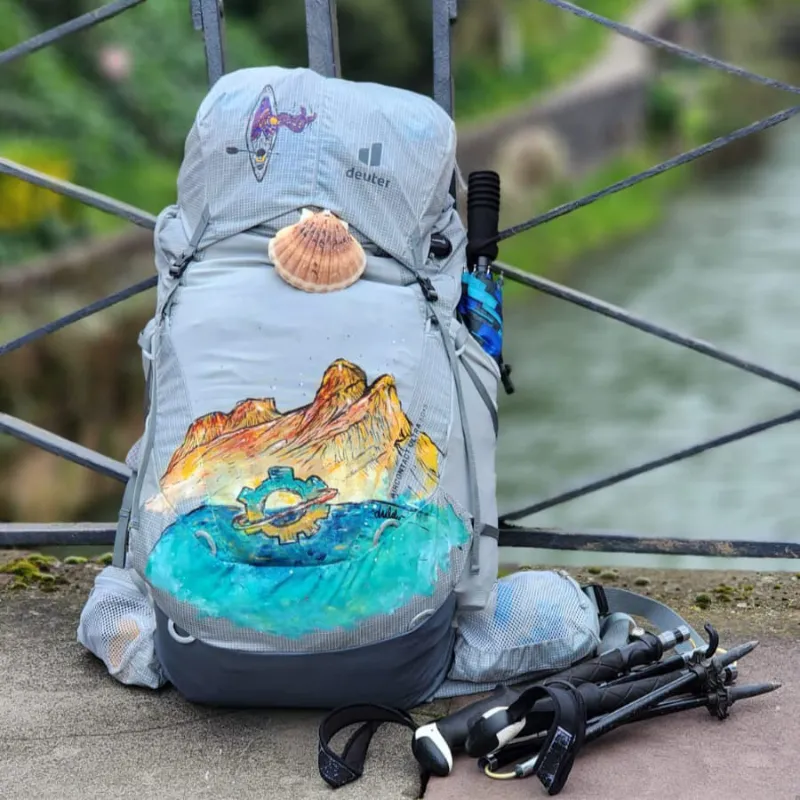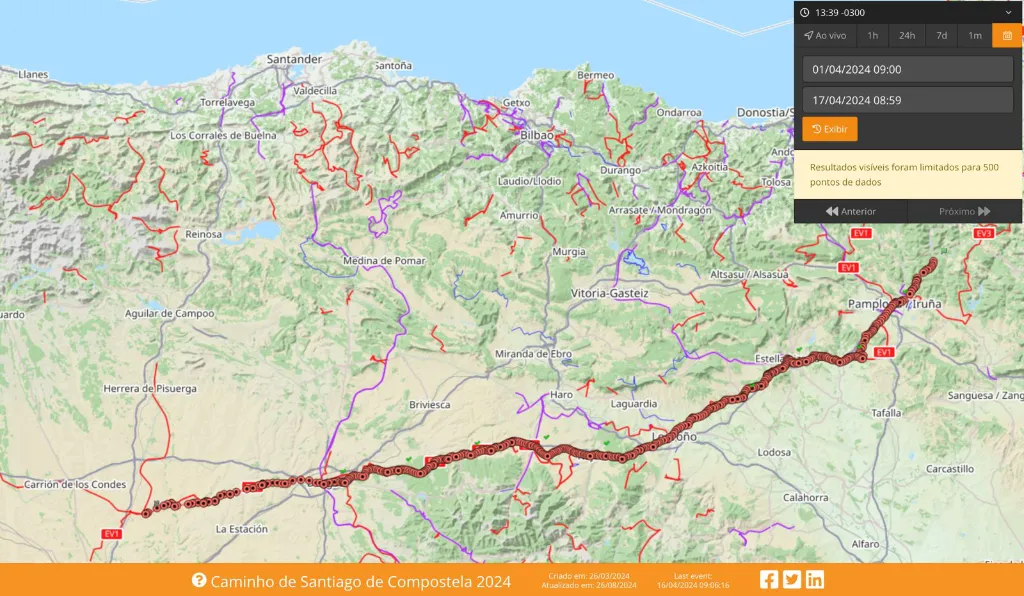Being well-equipped to face around a month of pilgrimage, considering weather changes and uneven terrain, is essential to ensure a safer experience on the Camino de Santiago.
We spoke with experts and pilgrims to bring the best tips on essential gear. Among them, Pedro Lacaz Amaral, founder of Gear Tips, who has been giving lectures on gear for pilgrims since 2002, and who recently walked the Camino de Santiago.
Socks and Footwear: The Two Most Important Items for the Pilgrimage
When setting off on the Camino de Santiago, footwear and socks should be the first investments every pilgrim makes. Ana Wanke suggests buying them together. If you already have socks, take them with you when shopping for shoes.
Pedro Lacaz Amaral emphasizes that socks are also gear! “There’s no point in having high-tech shoes if you’re wearing cotton socks.”
Socks: How to Choose the Right Pair
Socks should have the technology to transport moisture away from your feet, helping to prevent blisters. Ana recommends socks from the Lorpen brand. According to Pedro Lacaz Amaral, some models have a thicker, cushioned layer on the soles that helps with shock absorption. “I use Lorpen socks, a brand I distributed in Brazil from 2010 to around 2018, mainly because of its T3 technology,” says Pedro.
In this article, Pedro Lacaz Amaral presents the features and benefits of Lorpen socks.
Liner socks: liner socks are very thin and recommended for those with very sensitive feet. They should be worn together with another sock to minimize friction.
Toe socks: this model helps prevent blisters and chafing between the toes. “I chose to wear Injinji socks, an American brand I’ve used for years, underneath my Lorpen socks,” says Pedro.
Toe socks also helped pilgrim Marianna Sergio on the Camino. “When a fellow pilgrim saw my feet full of blisters, he gave me a pair as a gift. These socks were essential for me to continue walking.”
Another tip is to avoid short socks, as they expose your heels while walking, causing injuries.

Footwear: What to Wear on Your Feet for the Camino de Santiago
Boots or trail runners
Whether you choose to walk the Camino de Santiago in boots or trail runners, it’s essential that your shoes, like your socks, are breathable.
The footwear must feel comfortable on your feet. In general, pilgrims—as well as athletes from other fields like high-altitude climbing or trail running—should choose a size up from their usual everyday shoes. But be careful: in addition to making sure the shoe isn’t too loose, make sure it breaks in well—especially boots. Also, consider your gait type.
Furthermore, prioritize shoes with good cushioning, which make walking more comfortable and help prevent injuries. It’s also important to evaluate the insoles, outsoles, and laces. Ana also advises taking extra insoles along the way.
Pedro Lacaz Amaral highlights some key points to consider:
- The choice between boots or trail runners is very personal. Boots offer more ankle support but tend to be heavier, while trail runners provide greater freedom of movement and are lighter.
- Waterproofing: keep in mind that although waterproofing keeps light rain out, heavy rain or river crossings can still let water in, which may then get trapped inside the shoes.
“My Camino de Santiago experience was with Gore-Tex trail runners, a waterproof membrane. However, upon reflection, I realized I might have preferred shoes without this technology. I sweat a lot, so my feet were often damp, which could have caused blisters had I not been careful to dry them and remove my shoes during breaks.”
So, waterproofing is a factor to consider, but it’s important to reflect on your personal needs.
Sandals and flip-flops
Besides allowing your feet to rest while visiting cities and villages after a long walking day, sandals can help pilgrims keep going when their feet are injured. With her toenail and cuticle damaged, Marianna decided to buy a pair of sandals mid-way and used them for four days. “I wore them with toe socks to avoid friction.”
Flip-flops are mainly useful for showers, but Pedro points out that the lighter your backpack, the better. “You need to choose what to carry with discernment and coherence. I only took sandals. I considered flip-flops for showering, but opted for something safer for walking in the cities after leaving my things at the albergue.”
A tip: if you shower with your sandals on, do it at night and carry them on the outside of your backpack the next day to dry as you walk.
Clothing for the Camino de Santiago
As in other outdoor activities where weather conditions are unpredictable, the layering system helps organize your daily gear and keeps your body at the right temperature throughout the pilgrimage.
First layer: everything in direct contact with your body. Its purpose is moisture management. In hot weather, it should maximize heat loss through evaporation. In cold weather, it should both manage moisture and retain heat.
Second layer: meant to retain the heat your body produces. Fleece jackets or insulated jackets are recommended.
Third layer: the final layer is designed to shield you from the elements—rain, wind, or snow. Usually, this is a waterproof and breathable shell, like an anorak.
“Some people opt to bring thermal underwear as a first layer for cold weather, but I just packed a long-sleeve shirt with a hood to help protect from the sun. In cold situations like crossing the Pyrenees, the second and third layers were enough. Carrying thermal underwear for rare use didn’t make sense to me due to extra weight and bulk,” says Pedro.
To protect your lower body, Pedro uses just the first layer, typically zip-off pants. For rain or cold, a waterproof and breathable overpant is advised.
Don’t forget to bring bandanas, a cap, and sunglasses.
Backpack: Ideal Size and Model
Nowadays, backpacks of all sizes can be seen on the Camino de Santiago. As many people have their luggage forwarded from one albergue to another, it’s common to see pilgrims carrying only small backpacks (10 to 20 liters), enough for the day’s essentials.
However, since this article is focused on those carrying all their gear, Pedro recommends packs of around 35 liters.
“In the training sessions I’ve taught since 2002, I always talked about the Deuter Futura PRO 34 SL for women and the Futura PRO 36 for men. But it really depends on what you need to carry, your size, and your specific needs. I chose a larger pack, the Deuter Aircontact Ultra 50+5. Since I’m 1.92 m tall, my clothes, sleeping bag, and other items are bulkier. I could have gone with the smaller version of this model—the Deuter Aircontact Ultra 40+5—but the weight difference was negligible, and I preferred the convenience of the larger pack.”

In this article, Pedro Lacaz Amaral offers key insights on weight and volume differences in backpacks, based on needs and individual differences.
Sleeping System
The sleeping bag on the Camino de Santiago or on most Multi-Day Hikes is used as bedding.
“Since pilgrims sleep in hostels and sometimes hotels, there’s no need for a sleeping bag for very low temperatures—unless you’re going in winter, which changes things a bit. Sleeping bags like the Deuter Dream Lite and the Micron from NTK are more than sufficient. Many people also use just a liner to go ultralight. I chose a Sea to Summit sleeping bag, the Traveller Tr 1, a relatively unique model because it has no hood and opens up fully like a blanket. It’s filled with goose down, is very light, and very versatile,” explains Pedro.
Trekking Poles
The foldable model, also known as Z-fold, is recommended for its easy storage in your backpack during the hike. But regardless of the model, don’t forget to bring a pair of poles!
Headlamp
Pedro recommends headlamps, which take up less space and leave your hands free during the walk. The model he used was the Spot R 400 Black Diamond. “One important feature is that the headlamp has a red LED.”
In this video, Pedro Lacaz Amaral shares five valuable tips about gear for pilgrims. One of them is the use of a headlamp.
Basic Kit to Care for Feet and Skin
- “Blister kit”: Ana Wanke recommends that pilgrims carry alcohol, Benzoin gel to dry blisters, antiseptic, disposable needles, non-stick dressings, scissors, kinesio tape or elastic bandages, and hydrocolloid dressings.
- Moisturizing and lubricating creams to prevent foot blisters. Pedro used NOK cream from Akileine and shares his experience in this article.
- Lysoform or anti-odor spray to prevent unpleasant smells in boots or trail runners.
Don’t forget to pack sunscreen and lip balm to protect your skin during the pilgrimage.
Technology
Personal tracker or GPS: even though the French Way is well-marked, Pedro recommends using the SPOT Gen4. “During the pilgrimage, I disconnected from the ‘outside world’. My only communication with family and friends so they’d know where I was—and that I was okay—was through the SPOT Gen4 satellite personal tracker.”

Below, Pedro describes the three features he used during the Camino de Santiago:
- Tracking mode: the device sent my location via satellite every 10 minutes (you can set the interval). Through the shared map link, people followed me in real-time.
- Preset message: I created the message, “Good morning! Starting another day of hiking!” and registered ten contacts (email and SMS) who received that message along with my exact location.
- Check-in: at the end of each day’s hike, I sent a message saying “I arrived at my destination for the day!” when I reached the city where I’d sleep.
We’ve gathered a helpful article and a free SPOT course so you can understand how trackers work: everything about SPOT trackers and Free SPOT course at Gear Tips Academy.
This post is also available in: Português (Portuguese (Brazil)) Español (Spanish)
